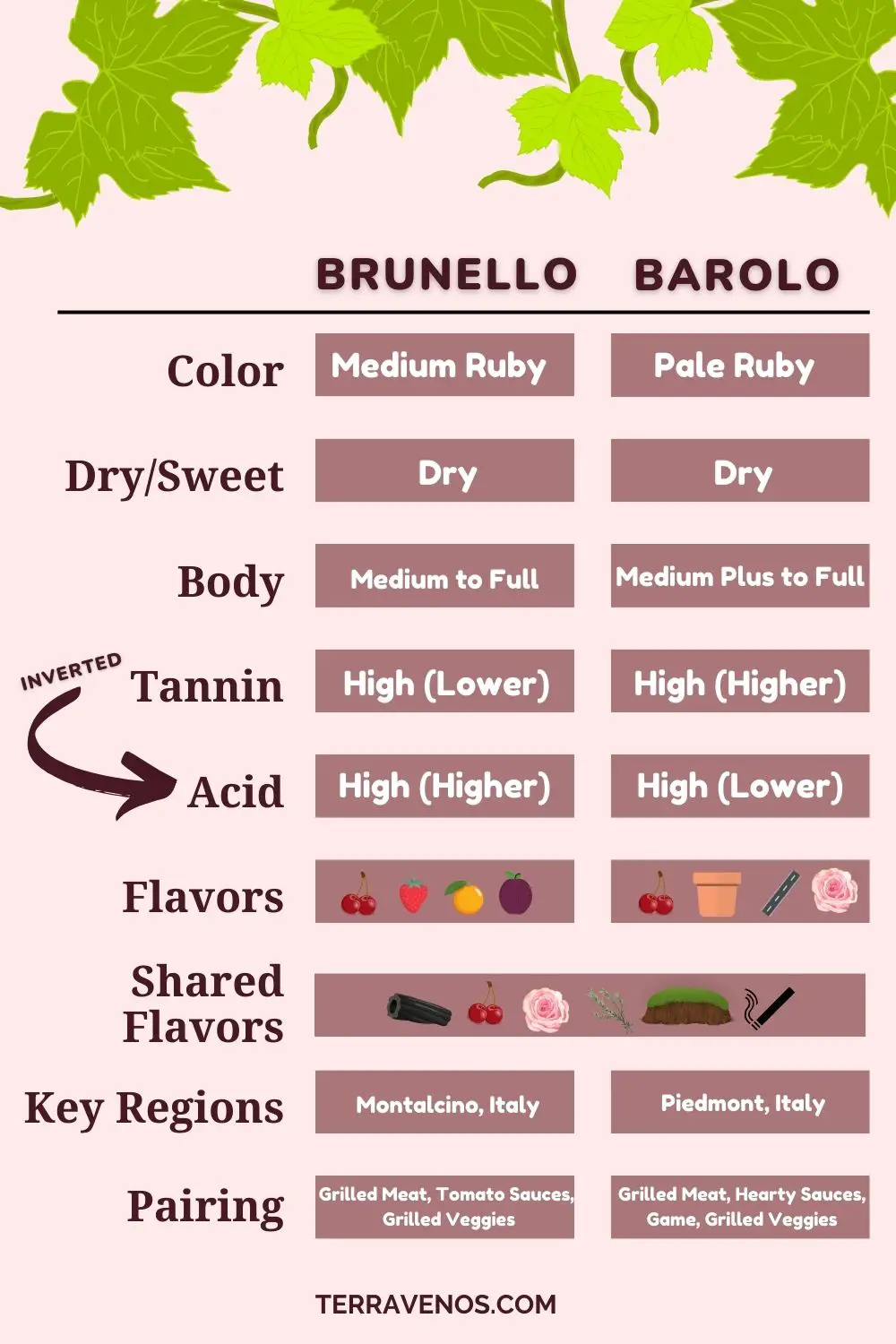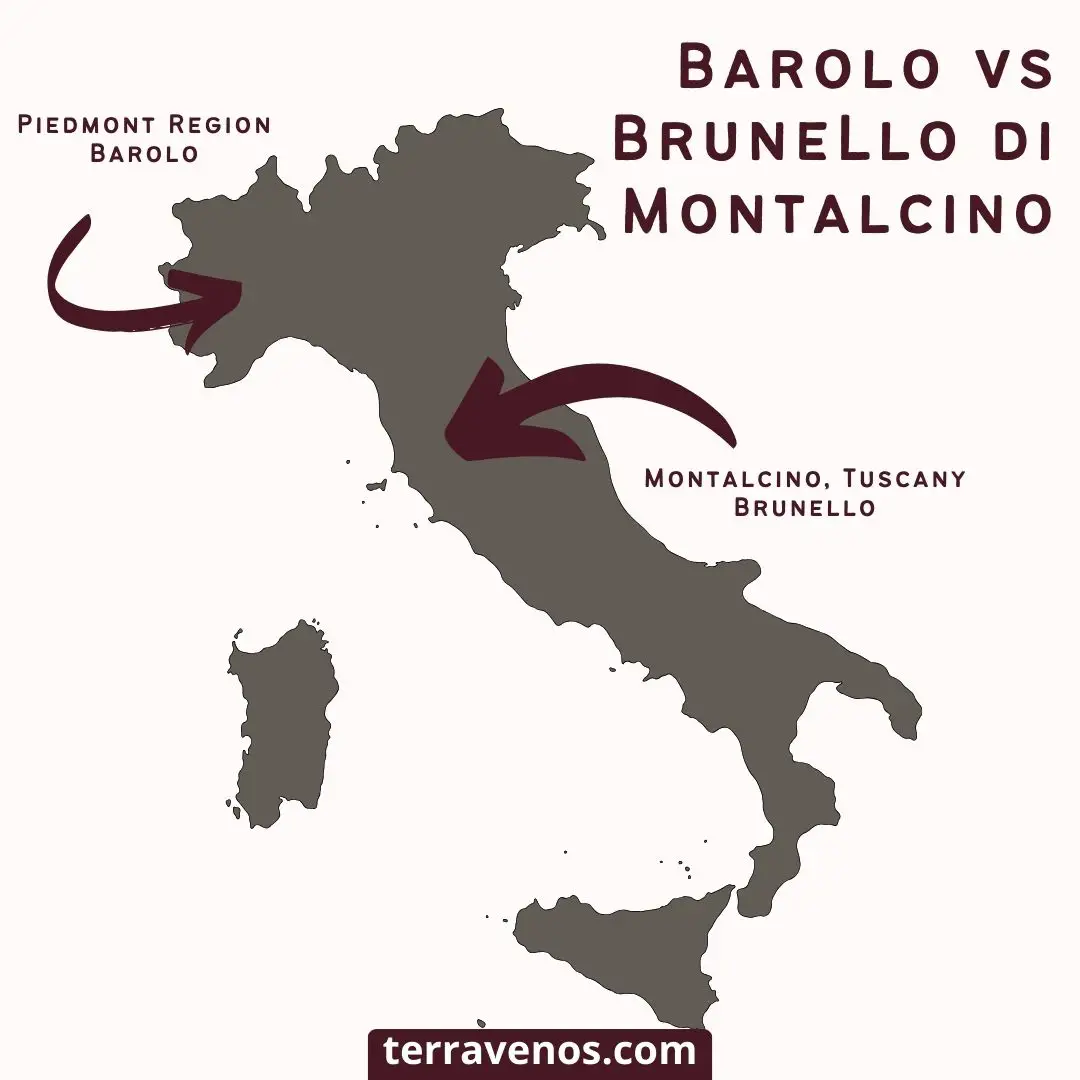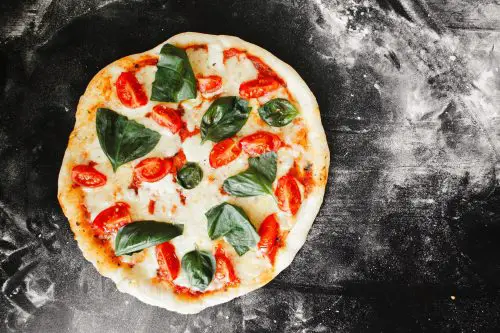
Barolo and Brunello are Italian red wines. Barolo, made from 100% Nebbiolo, is robust with cherry, clay, rose, tar, and higher tannins. Brunello is 100% Sangiovese with bright red fruit and higher acid. Here’s what you need to know about Barolo vs. Brunello.
Where Are Barolo and Brunello Wines Made?

Barolo and Brunello are both Italian wines. Barolo’s made in the Piedmont region of northwestern Italy. Brunello’s made further south in Tuscany. Check out the map above.
Barolo Wine: Quick Overview
Barolo Overview: A Taste of Piedmont
In the picturesque northern Italian region of Piedmont, Barolo stands as the most renowned wine. Crafted exclusively from 100% Nebbiolo grapes, Barolo earned its stripes early on, achieving DOCG status in 1980. The heart of production lies in the Barolo Zone, encompassing:
- Barolo
- La Morra
- Castiglione Falletto
- Serralunga d’Alba, and
- Monforte d’Alba
Historical Roots: A Regal Connection
The roots of Barolo trace back to the mid-1800s when advancements in winemaking elevated the quality of wines, capturing the favor of local royalty. Its moniker, the “king of wines,” pays homage to King Carlo Alberto di Savoia, credited for planting many of Barolo’s original vineyards.
Characteristics: Complexity Unveiled
Barolo stands out for its complexity and age-worthy nature. Notably, its intense tannins demand years of patient aging to achieve a drinkable balance.
Personal Note: Barolo is a grownup wine. This is not a red wine for beginners. They require an open mind and thirsty palate that understands this unique wine’s qualities.
Modernization and Styles: The Barolo Wars Saga
The 1970s and ’80s witnessed the Barolo Wars, a period marked by conflicting winemaking approaches. Some producers embraced modern techniques, utilizing roto-fermenters and Bordeaux-style new oak barrels. This shift aimed to create wines with softer tannins for more immediate enjoyment. Notably, producers like Vietti cater to diverse tastes by offering both traditional and modern styles.
Evolution of Production: From Co-operative to Estate
In the annals of Barolo’s production, a significant shift occurred from co-operative winemaking dominance to the prevalence of estate bottling. Today, top producers focus on crafting single vineyard expressions, showcasing the best of Barolo’s terroir.
Fun Wine Fact: Barolo’s custom of small, handcrafted estate wines with independent producers means that these wines can command some of the highest prices in Italy. Many Italian wine regions depend on large cooperatives capable of making vast quantities of inexpensive wines. Not Barolo.
Brunello Unveiled: Tuscany’s Red Elegance
Brunello Overview: A Tuscan Legend
Nestled in the heart of Tuscany, central Italy, Brunello di Montalcino, affectionately known as Brunello, emerges as a distinguished red wine. Its name, derived from the Italian word for “brown” (bruno), and the town of Montalcino in the province of Siena, paints a vivid picture of its origins. Despite early beliefs that it was a separate variety, DNA evidence confirms that Brunello is, in fact, Sangiovese. Brunello di Montalcino earned DOCG status in 1980. It must be made from 100 percent Sangiovese grapes, making it unique from Chianti.
Helpful Tip: Here’s how to tell the difference between the Italian wine rankings – IGT, DOC, and DOCG.
Historical Roots: The Biondi-Santi Legacy
Developing around the same time as Barolo, Brunello di Montalcino has a unique beginning, exclusively produced by the Biondi-Santi family. Its rarity added to its allure, with production limited to four exceptional vintages between 1865 (its first vintage) and 1945. During this period, Brunello was the most expensive wine in Italy. Post-World War II, other producers began making Brunello, increasing production, but Bondi Santi remains legendary.
Fun Wine Fact: A Bondi Santi Brunello di Montalcino will cost you $250+ USD. Good stuff.
Regulations and Aging: The Oak Embrace
DOCG regulations dictate that Brunello di Montalcino spends a minimum of two years of aging in oak barrels. Similar to Barolo, producers follow varied approaches, employing traditional large oak casks or modern small French oak barrels. The total aging process, including cask and bottle aging, spans at least five years before release. Notably, wines labeled Brunello Riserva must endure a minimum of six years of aging before finding their way into your glass.
Barolo vs Brunello: Flavors
Barolo Wine Flavors
- Plum
- Raspberry
- Tar
- White truffle
- Rose petals
- Cherry
- Leather
- Licorice
- Tobacco
- Earthy notes
- Anise
- Dried herbs
- Balsamic
Brunello di Montalcino Wine Flavors
- Cranberry
- Strawberry
- Espresso
- Sundried tomato
- Cherry
- Tobacco leaf
- Leather
- Dried fig
- Violet
- Cocoa
- Almond
- Cedar
- Vanilla
Barolo vs Brunello Wine Food Pairing Chart

If you’re trying to figure out the difference between Barolo vs Brunello when it comes to cuisine, here’s a quick guide to get you started:
| Barolo Wine | Brunello Wine |
|---|---|
| Margherita Pizza (V) | Margherita Pizza (V) |
| Mushroom Risotto (V) | Pesto Pasta (V) |
| Grilled Chicken | Eggplant Parmesan (V) |
| Roast Chicken | Grilled Chicken |
| Beef Stew | Porcini Mushroom Risotto (V) |
| Beef Tenderloin | Osso Buco |
| Wild Boar Ragù | Truffle Risotto (V) |
| Pappardelle with Wild Boar | Filet Mignon |
| Osso Buco | Wild Boar Ragù |
| Truffle Risotto (V) | Duck Confit |
Thirsty for More?
Check out the differences between Nebbiolo and Barbera next, or head over to this post that will tell you how to pick out a decent Chianti wine.



